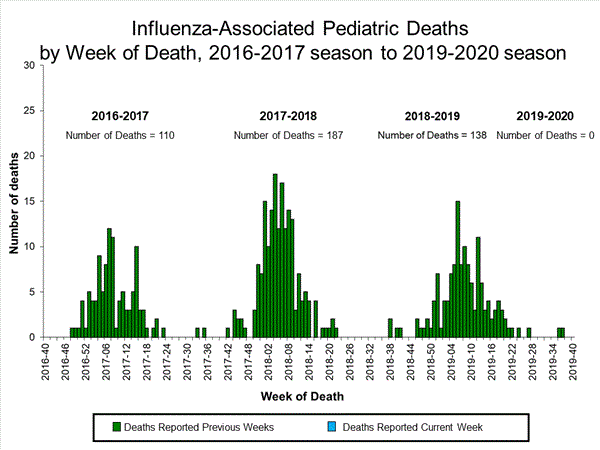U.S. Virologic Surveillance
The results of tests performed by clinical laboratories nationwide are summarized below. Data from clinical laboratories (the percent of specimens tested that are positive for influenza) are used to monitor whether influenza activity is increasing or decreasing.
| Clinical Laboratories | Week 41 | Data Cumulative since September 29, 2019 (week 40) |
|---|---|---|
| No. of specimens tested | 16,672 | 34,990 |
| No. of positive specimens (%) | 573 (3.4%) | 1,075 (3.1%) |
| Positive specimens by type | ||
| Influenza A | 150 (26.2%) | 311 (28.9%) |
| Influenza B | 423 (73.8%) | 764 (71.1%) |
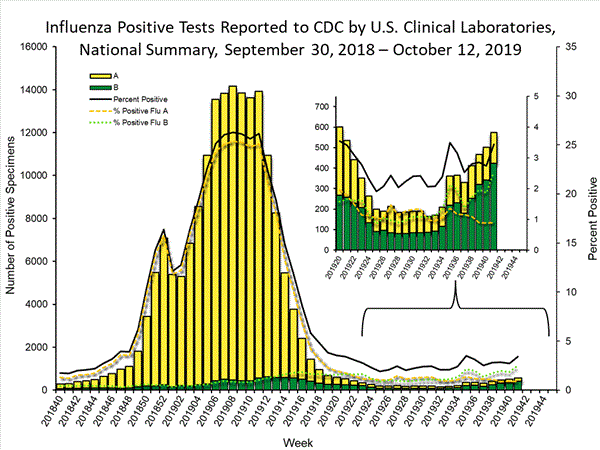
View National and Regional Level Graphs and Data | View Chart Data | View Full Screen | View PowerPoint Presentation
The results of tests performed by public health laboratories nationwide are summarized below. Data from public health laboratories are used to monitor the proportion of circulating viruses that belong to each influenza subtype/lineage.
| Public Health Laboratories | Week 41 | Data Cumulative since September 29, 2019 (week 40) |
|---|---|---|
| No. of specimens tested | 407 | 1,029 |
| No. of positive specimens* | 64 | 176 |
| Positive specimens by type/subtype | ||
| Influenza A | 44 (68.8%) | 119 (67.6%) |
| (H1N1)pdm09 | 9 (24.3%) | 24 (27.3%) |
| H3N2 | 28 (75.7%) | 64 (72.7%) |
| Subtyping not performed | 7 | 31 |
| Influenza B | 20 (31.3%) | 57 (32.4%) |
| Yamagata lineage | 2 (16.7%) | 3 (7.5%) |
| Victoria lineage | 10 (83.3%) | 37 (92.5%) |
| Lineage not performed | 8 | 17 |
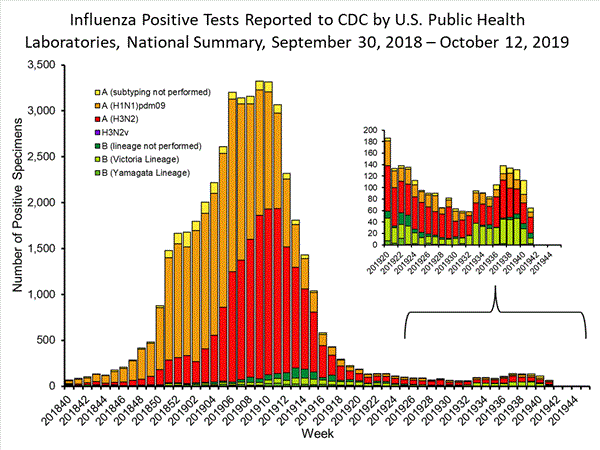
View National and Regional Level Graphs and Data | View Chart Data | View Full Screen | View PowerPoint Presentation
Additional virologic surveillance information for this season and past seasons:
Surveillance methods - http://www.cy118119.com/flu/weekly/overview.htm#anchor_1539281228772
National, regional and state data - http://gis.cdc.gov/grasp/fluview/fluportaldashboard.html
Age group data - http://gis.cdc.gov/grasp/fluview/flu_by_age_virus.html
Influenza Virus Characterization
CDC performs genetic and antigenic characterization of U.S. viruses submitted from state and local health laboratories using Right Size Roadmap submission guidance. These data are used to compare how similar the currently circulating influenza viruses are to the reference viruses used for developing new influenza vaccines and to monitor evolutionary changes that continually occur in influenza viruses circulating in humans. CDC also tests susceptibility of influenza viruses to antiviral medications including the neuraminidase inhibitors (oseltamivir, zanamivir, and peramivir) and the PA endonuclease inhibitor baloxavir.
Virus characterization data will be updated starting later this season when sufficient numbers of specimens have been tested.
Outpatient Illness Surveillance
Nationwide during week 41, 1.5% of patient visits reported through the U.S. Outpatient Influenza-like Illness Surveillance Network (ILINet) were due to influenza-like illness (ILI). This percentage is below the national baseline of 2.4%.
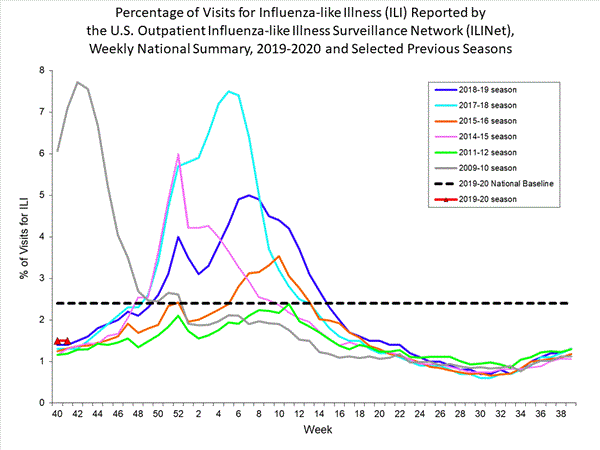
View National and Regional Level Graphs and Data | View Chart Data | View Full Screen | View PowerPoint Presentation
On a regional level, the percentage of outpatient visits for ILI ranged from 1.0% to 2.6% during week 41. All regions reported a percentage of outpatient visits for ILI below their region-specific baselines.
Data collected in ILINet are used to produce a measure of ILI activity* by state. During week 41, the following ILI activity levels were experienced:
- High 鈥?1 state (Louisiana)
- Low 鈥?U.S. Virgin Islands
- Minimal 鈥?District of Columbia, New York City, Puerto Rico and 49 states (Alabama, Alaska, Arizona, Arkansas, California, Colorado, Connecticut, Delaware, Florida, Georgia, Hawaii, Idaho, Illinois, Indiana, Iowa, Kansas, Kentucky, Maine, Maryland, Massachusetts, Michigan, Minnesota, Mississippi, Missouri, Montana, Nebraska, Nevada, New Hampshire, New Jersey, New Mexico, New York, North Carolina, North Dakota, Ohio, Oklahoma, Oregon, Pennsylvania, Rhode Island, South Carolina, South Dakota, Tennessee, Texas, Utah, Vermont, Virginia, Washington, West Virginia, Wisconsin and Wyoming)
*Data collected in ILINet may disproportionally represent certain populations within a state, and therefore, may not accurately depict the full picture of influenza activity for the whole state. Differences in the data presented here by CDC and independently by some state health departments likely represent differing levels of data completeness with data presented by the state likely being the more complete.
Additional information about medically attended visits for ILI this season and past:
Surveillance methods - http://www.cy118119.com/flu/weekly/overview.htm#anchor_1571167821424
National, regional and state data - http://gis.cdc.gov/grasp/fluview/fluportaldashboard.html
ILI Activity Indicator Map for past weeks - https://gis.cdc.gov/grasp/fluview/main.html
Geographic Spread of Influenza as Assessed by State and Territorial Epidemiologists
The influenza activity reported by state and territorial epidemiologists indicates geographic spread of influenza viruses but does not measure the severity of influenza activity.
During week 41 the following influenza activity was reported:
- Regional 鈥?one state (Louisiana)
- Local 鈥?three states (California, Kentucky and Nevada).
- Sporadic 鈥? the District of Columbia, Puerto Rico, the U.S. Virgin Islands and 43 states (Alabama, Alaska, Arizona, Arkansas, Colorado, Connecticut, Delaware, Florida, Georgia, Hawaii, Idaho, Illinois, Indiana, Iowa, Kansas, Maine, Maryland, Massachusetts, Michigan, Minnesota, Missouri, Montana, Nebraska, New Jersey, New Mexico, New York, North Carolina, North Dakota, Ohio, Oklahoma, Oregon, Pennsylvania, South Carolina, South Dakota, Tennessee, Texas, Utah, Vermont, Virginia, Washington, West Virginia, Wisconsin and Wyoming).
- No activity 鈥?three states (Mississippi, New Hampshire and Rhode Island).
- Guam did not report.
Additional information about the geographic spread of influenza this season and past seasons:
Surveillance methods - http://www.cy118119.com/flu/weekly/overview.htm#anchor_1568388833450m
Map for past weeks - https://gis.cdc.gov/grasp/fluview/FluView8.html
Influenza-Associated Hospitalizations
The Influenza Hospitalization Surveillance Network (FluSurv-NET) conducts population-based surveillance for laboratory-confirmed influenza-related hospitalizations in select counties in the Emerging Infections Program (EIP) states and Influenza Hospitalization Surveillance Project (IHSP) states. FluSurv-NET estimated hospitalization rates will be updated weekly starting later this season when a sufficient number of hospitalizations have been reported. 聽
Additional FluSurv-NET data can be found at: http://gis.cdc.gov/GRASP/Fluview/FluHospRates.html and http://gis.cdc.gov/grasp/fluview/FluHospChars.html.
Pneumonia and Influenza (P&I) Mortality Surveillance
Based on National Center for Health Statistics (NCHS) mortality surveillance data available on October 17, 2019, 4.7% of the deaths occurring during the week ending October 5, 2019 (week 40) were due to P&I. This percentage is below the epidemic threshold of 5.7% for week 40.
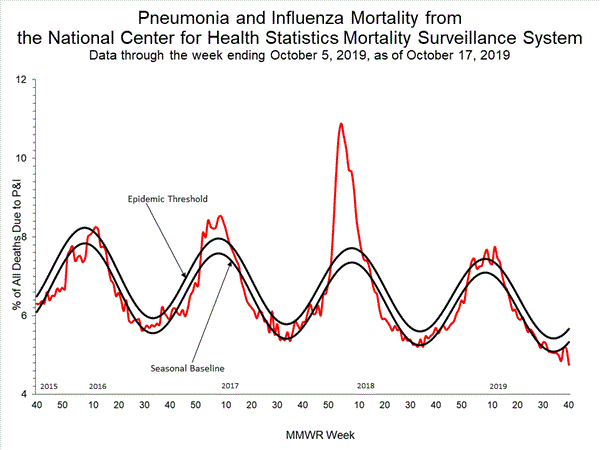
View Regional and State Level Data | View Chart Data | View Full Screen | View PowerPoint Presentation
Additional pneumonia and influenza mortality surveillance information for current and past seasons:
Surveillance methods - http://www.cy118119.com/flu/weekly/overview.htm#anchor_1539281356004
National, regional and state data - https://gis.cdc.gov/grasp/fluview/mortality.html
Age group data- https://gis.cdc.gov/grasp/fluview/mortality.html
Influenza-Associated Pediatric Mortality
No influenza-associated pediatric deaths were reported to CDC during week 41.
No influenza-associated pediatric deaths occurring during the 2019-2020 season have been reported.
Additional Influenza-associated pediatric mortality surveillance information for current and past seasons:
Surveillance methods - http://www.cy118119.com/flu/weekly/overview.htm#anchor_1571168571051
Basic demographics, underlying conditions, bacterial co-infections, and place of death for the current and past seasons - https://gis.cdc.gov/GRASP/Fluview/PedFluDeath.html
Additional National and International Influenza Surveillance Information
FluView Interactive: FluView includes enhanced web-based interactive applications that can provide dynamic visuals of the influenza data collected and analyzed by CDC. These FluView Interactive applications allow people to create customized, visual interpretations of influenza data, as well as make comparisons across flu seasons, regions, age groups and a variety of other demographics. To access these tools, visit http://www.cy118119.com/flu/weekly/fluviewinteractive.htm
National Institute for Occupational Safety and Health: Monthly surveillance data on the prevalence of health-related workplace absenteeism among full-time workers in the United States are available from NIOSH at http://www.cy118119.com/niosh/topics/absences/default.html
U.S. State and local influenza surveillance: Click on a jurisdiction below to access the latest local influenza information
World Health Organization: Additional influenza surveillance information from participating WHO member nations is available through FluNet and the Global Epidemiology Reports.
WHO Collaborating Centers for Influenza located in Australia, China, Japan, the United Kingdom, and the United States (CDC in Atlanta, Georgia).
Europe: For the most recent influenza surveillance information from Europe, please see WHO/Europe and the European Centre for Disease Prevention and Control at http://www.flunewseurope.org/.
Public Health Agency of Canada: The most up-to-date influenza information from Canada is available at http://www.phac-aspc.gc.ca/fluwatch/
Public Health England: The most up-to-date influenza information from the United Kingdom is available at https://www.gov.uk/government/statistics/weekly-national-flu-reports
Any links provided to non-Federal organizations are provided solely as a service to our users. These links do not constitute an endorsement of these organizations or their programs by CDC or the Federal Government, and none should be inferred. CDC is not responsible for the content of the individual organization web pages found at these links.
An overview of the CDC influenza surveillance system, including methodology and detailed descriptions of each data component, is available at: http://www.cy118119.com/flu/weekly/overview.htm.
--------------------------------------------------------------------------------